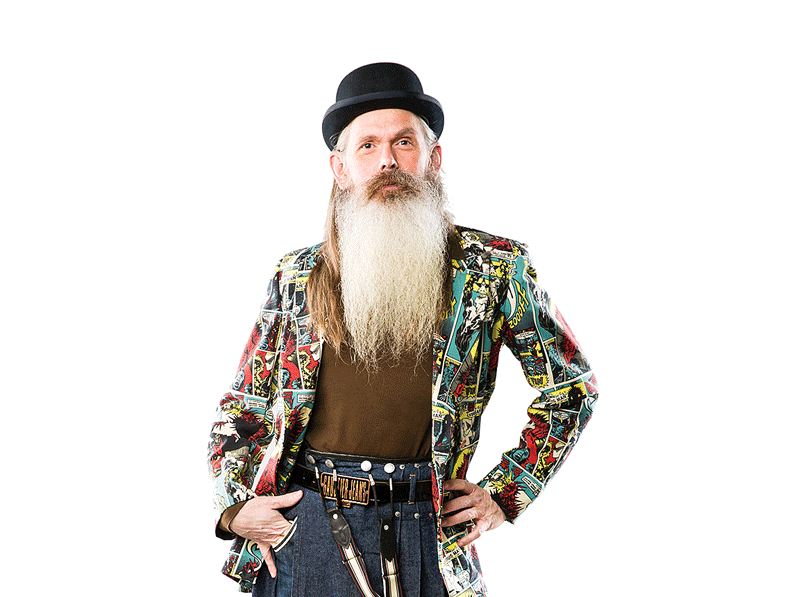Richard Anderson, Couture Collector

Richard Anderson Tony Valainis
You wear a lot of Jean-Paul Gaultier designs. Have you met him?
Twice. He wanted to know who tailored my clothing. I was like, “This is off the rack.” He said, “I don’t believe you,” and had me try on other jackets. He said I’m a better build than his house model. And I joked, “Well, can I have his job?” That’s one reason I bought his clothing, because I didn’t have to do anything to it to make it look great. This jacket is from his 1995 Fall collection. I bought it because it has a comic-book image of Madonna, and I love her. Also because it’s bizarre.
Tell us more about your relationship with Gaultier.
He has tagged me on Facebook before. He saw a photo of me and was like, “Just proving the Gaultier image doesn’t age.” His atelier designed the jacket for me once, and I had it 3D-printed and wore it to a Gaultier event in Brooklyn. Then I donated it to a museum.
Why do you like to wear bizarre clothing?
It invites the right people in. It invites kindness.
How do you afford it?
I shop consignment at Designer Men’s Room in Broad Ripple. I’m a Hoosier. I’m not paying full price for anything.
What’s being a muse for many Indiana artists?
That is the whole reason I do it now—that community of artists … I give all these clothes I’ve collected, and they create around it.
Do you have a rule about consignment shopping?
If it’s in my size, I buy it. If it’s not, I leave it there. I let someone else have that joy. A lot of people will buy something and resell it. That’s not me. I don’t want to make money off what I collect. My clothes are my crayons of creativity. I want to have more colors. But don’t be greedy.
How do you decide what to wear every day?
When I wake up, I dress for how I feel. And I’m grateful for every day because there was a time where I tried to end my life. It’s my way of saying that I’m glad I didn’t succeed. I was 16 and I was gay and it was just an awful time. It was one of those kids, from Indiana, that was so bullied from being different in that regard that it gets to you.

Our March ‘My Look,’ Richard AndersonTony Valainis
That’s a story you share in a new book, Crashing Through the Front Door, about the LGBTQ community in Indy, by local writer Taylor Rose and photographer Casey No.
I got to tell what it was like to be a closeted, very religious gay kid in Indiana, and how that religion almost killed me, literally. And How textiles and fashion and finding my own tribe got me through it, helped me to succeed and be extroverted. I’m actually an introvert.
Why did you stay here?
I’m proud to be from Indianapolis. And I don’t want to move to be creative. So I just get creative where I’m at.
Who are your fashion idols?
David Bowie. And change. Don’t be afraid of change. It doesn’t hurt you. You’ll learn something from it.
It would surprise people to know that you actually spent many years working in a Ford factory.
My home base was here, the Shadeland plant. I did quality assurance. When there was a problem, if you saw me coming in, it wasn’t good for you. And Ford paid for me to go to M.I.T., got my training there. My specialty is porosity of metals—air bubbles in metal, whenever you have vacuum injections in moldings. I had a great career with Ford. I excelled at it.
Where is the best fashion happening in Indianapolis?
The kids at Low Pone (a monthly queer dance party in Fountain Square)—that’s your fashion and your creativity. Those are the kids who don’t’ have a dime. But oh, my god, look at what they’re making. What they’re doing.
Best fashion advice?
As Karl Lagerfeld said, “Trendy is the last stop before tacky.”





